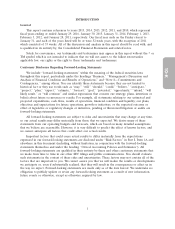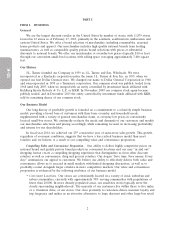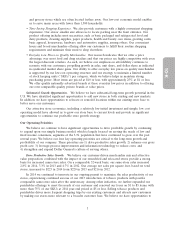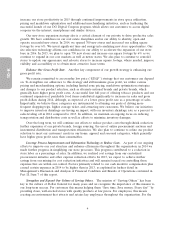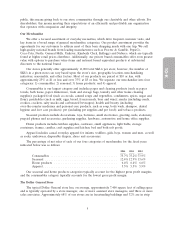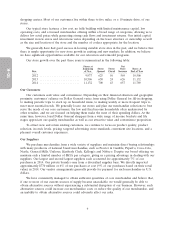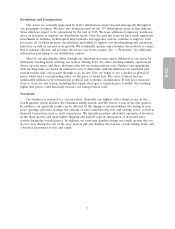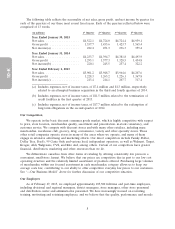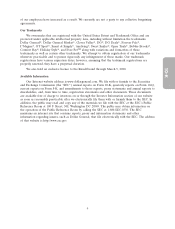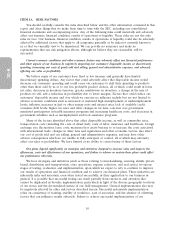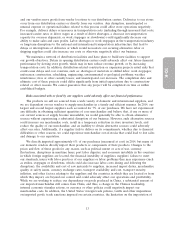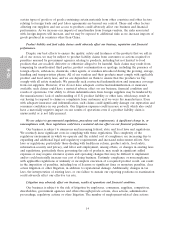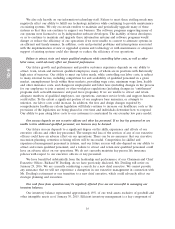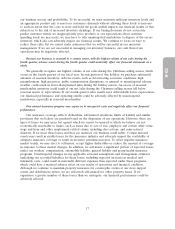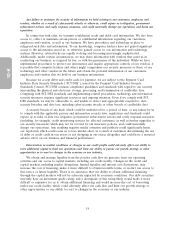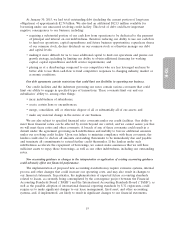Dollar General 2014 Annual Report Download - page 84
Download and view the complete annual report
Please find page 84 of the 2014 Dollar General annual report below. You can navigate through the pages in the report by either clicking on the pages listed below, or by using the keyword search tool below to find specific information within the annual report.
10-K
ITEM 1A. RISK FACTORS
You should carefully consider the risks described below and the other information contained in this
report and other filings that we make from time to time with the SEC, including our consolidated
financial statements and accompanying notes. Any of the following risks could materially and adversely
affect our business, financial condition, results of operations or liquidity. These risks are not the only
risks we face. Our business, financial condition, results of operations or liquidity could also be adversely
affected by additional factors that apply to all companies generally or by risks not currently known to
us or that we currently view to be immaterial. We can provide no assurance and make no
representation that our risk mitigation efforts, although we believe they are reasonable, will be
successful.
Current economic conditions and other economic factors may adversely affect our financial performance
and other aspects of our business by negatively impacting our customers’ disposable income or discretionary
spending, increasing our costs of goods sold and selling, general and administrative expenses, and adversely
affecting our sales or profitability.
We believe many of our customers have fixed or low incomes and generally have limited
discretionary spending dollars. Any factor that could adversely affect that disposable income would
decrease our customers’ spending and could cause our customers to shift their spending to products
other than those sold by us or to our less profitable product choices, all of which could result in lower
net sales, decreases in inventory turnover, greater markdowns on inventory, a change in the mix of
products we sell, and a reduction in profitability due to lower margins. Factors that could reduce our
customers’ disposable income and over which we exercise no influence include but are not limited to
adverse economic conditions such as increased or sustained high unemployment or underemployment
levels, inflation, increases in fuel or other energy costs and interest rates, lack of available credit,
consumer debt levels, higher tax rates and other changes in tax laws, concerns over government
mandated participation in health insurance programs and increasing healthcare costs, and decreases in
government subsidies such as unemployment and food assistance programs.
Many of the factors identified above that affect disposable income, as well as commodity rates,
transportation costs (including the costs of diesel fuel), costs of labor, insurance and healthcare, foreign
exchange rate fluctuations, lease costs, measures that create barriers to or increase the costs associated
with international trade, changes in other laws and regulations and other economic factors, also affect
our cost of goods sold and our selling, general and administrative expenses, and may have other
adverse consequences which we are unable to fully anticipate or control, all of which may adversely
affect our sales or profitability. We have limited or no ability to control many of these factors.
Our plans depend significantly on strategies and initiatives designed to increase sales and improve the
efficiencies, costs and effectiveness of our operations, and failure to achieve or sustain these plans could affect
our performance adversely.
We have strategies and initiatives (such as those relating to merchandising, sourcing, shrink, private
brand, distribution and transportation, store operations, expense reduction, and real estate) in various
stages of testing, evaluation, and implementation, upon which we expect to rely to continue to improve
our results of operations and financial condition and to achieve our financial plans. These initiatives are
inherently risky and uncertain, even when tested successfully, in their application to our business in
general. It is possible that successful testing can result partially from resources and attention that
cannot be duplicated in broader implementation, particularly in light of the diverse geographic locations
of our stores and the decentralized nature of our field management. General implementation also may
be negatively affected by other risk factors described herein. Successful systemwide implementation
relies on consistency of training, stability of workforce, ease of execution, and the absence of offsetting
factors that can influence results adversely. Failure to achieve successful implementation of our
10



